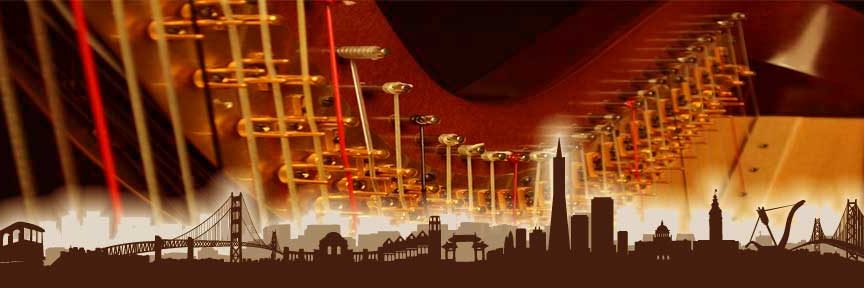By Dominique Piana
The 32nd Annual Historical Harp Society Conference was held from June 26 to 28, 2015, at St. Albert’s Priory in Oakland, under the direction of Cheryl Ann Fulton, our Western Region Director.
On Saturday morning, Mara Galassi from Milan, Italy, one of the foremost authorities on harps from the Baroque and classical eras, gave a talk on Transcribing the Music of J.S. Bach for the Harp. She shared with us her fascination with the Davidsharfe, the German harp from the High Baroque era. The question was not so much how to transcribe Bach’s music, but rather how to determine what music fit those harps from the time of Bach: mainly two-voiced polyphony, light and trebly. She showed images of harps from Nordhausen, a little town in Thuringia near Leipzig, where the harp maker Volckman Rabe’s harps abound in small local museums.
Cheryl Ann Fulton followed with a talk on Performing the P.J. Meyer Sonata, to be found in the first classical method for harp of the classical era: the 1963 Essai sur la vraie manière de jouer de la harpe, avec une méthode de l’accorder, republished as a facsimile by Fuzeau in France. Cheryl recently performed the Sonata on her newest acquisition, a single-action harp “à crochets” that has been beautifully restored, with original parts still intact.
Then it was Laura Peh’s turn, here all the way from Hong Kong/Singapore via London, enlightening us about The Performance History of Handel’s Harp Concerto in Georgian and Victorian Britain. We were told about all the Royal Harpists, with recognizable names like William Powell, the first performer of the concerto, John Parry, Edward Jones, John Balsir Chatterton, and John Thomas…. The Concerto, because it was later published for organ, got “lost and found”over and over. In the 19th century, it was Lady Llanover who was instrumental in keeping the Welsh triple harp, the instrument for which it was composed, in the public eye, and through the stories related to the concerto, we enjoyed a fun romp through British harp history.
After lunch, Emily Laurance, who is the head of the History Department at the San Francisco Conservatory, spoke about Romance and the Single-Action Harp: Musical Instruments and Generic Identity, examining the symbiotic relationship between the harp and the French vocal romance. This was a time of feminization of the harp, and the lyrics used often were pastoral or exotic (Southern France or Spanish) in inspiration, or harking back to idealized medieval times. One of the songs shown as an example was the famous Plaisir d’Amour by Martini.
Next Dominique Piana elaborated on the subject of J.B. Krumpholtz: “Modern” Experimentation in Harp Composition in the 18th Century. She read her freshly completed translation of Krumpholtz’s autobiography, as preserved by his disciple J.M. Plane in the Principes pour la Harpe. She related various incidents of his life and his passion for expanding the technical and emotional capabilities of the harp with the novelties found in his compositions: harmonics, étouffés and pedal glissés; complicated yet idiomatic finger patterns and complex modulations requiring the use of enharmonics. He was truly a man ahead of his time…
Later Cheryl Ann Fulton read Ron Cook’s paper What Can Historical Harpists Learn from the Cantigas Harps, as he was unable to come to the conference. It all started with the picture from the manuscript showing two harpists with their medieval harps. There was a discussion on the shape and form of the harps, on the musicians’ dress and its meaning, religious or otherwise, and on the poetry of the Cantigas. It turned out to be a quite thorny subject matter in terms of social and cultural mores! It was said in the beginning that iconography is notably unreliable to determine how harps were built and played in those ancient times. The same thought, rightly so, made a good conclusion.
Finally, Lisetta Rossi from Italy delighted us with her presentation Harps Over Seas: Italian Street Harpists in America in the 19th Century. She started out with the historical reasons for the concentration of harp builders and players in Basilicata’s Val d’Agri, in the South Italian Apennines. Street harpists from the area around Viggiano traveled all over Europe, then to America. Many prominent Italian American harpists also belonged to families with a long history of harp making and/or street playing, from Salvatore Mario De Stefano to the Salvis and the Vitos.
On Saturday evening, we were treated to a most exquisite concert in the chapel of the Priory, featuring Mara Galassi on arpa doppia, Vicente La Camera Mariño performing on a copy of the Trinity College harp, and Cheryl Ann Fulton’s Red Dragon Harp Ensemble of Welsh triple harps.
Sunday morning, Jennifer Sayre from San Luis Obispo explained the tablature used in the Compendio Numeroso para arpa de un orden, de dos ordenes, y de organo by Diego Fernandez de Huete. In honor of Alice Lawson Aber-Count, she delved into the intricacies of the Huete Compendio, the first harp method in existence, and actually a treatise on the diatonic (single row) and chromatic (cross-strung) Spanish harps.
Vicente La Camera Mariño shared with us about the two-way migrations of the Music and Dance of the Canaries, where he is from himself. Folk dance tunes from the Canary Islands spread throughout Europe all the way up to Scotland, then they were brought back to their place of origin in artful Western styles.
Sunday afternoon, Jennifer Sayre played works by Antonio de Cabezón on her “arpa de dos órdenes”, followed by Catherine Stiles on the triple harp, Vicente La Camera Mariño on a single-row “Vermillion” harp, in repertoire including Canaries from Scotland. Cheryl Ann Fulton’s Angelorum Medieval Harp Choir finished a program that stunned with its great delicacy and ethereal beauty. The location certainly contributed to the heavenly feel of both concerts, but the lightly strung period instruments themselves exuded a natural sweetness unmarred by harshness. Their sound reached the ear most gently, floating like an incantation.
